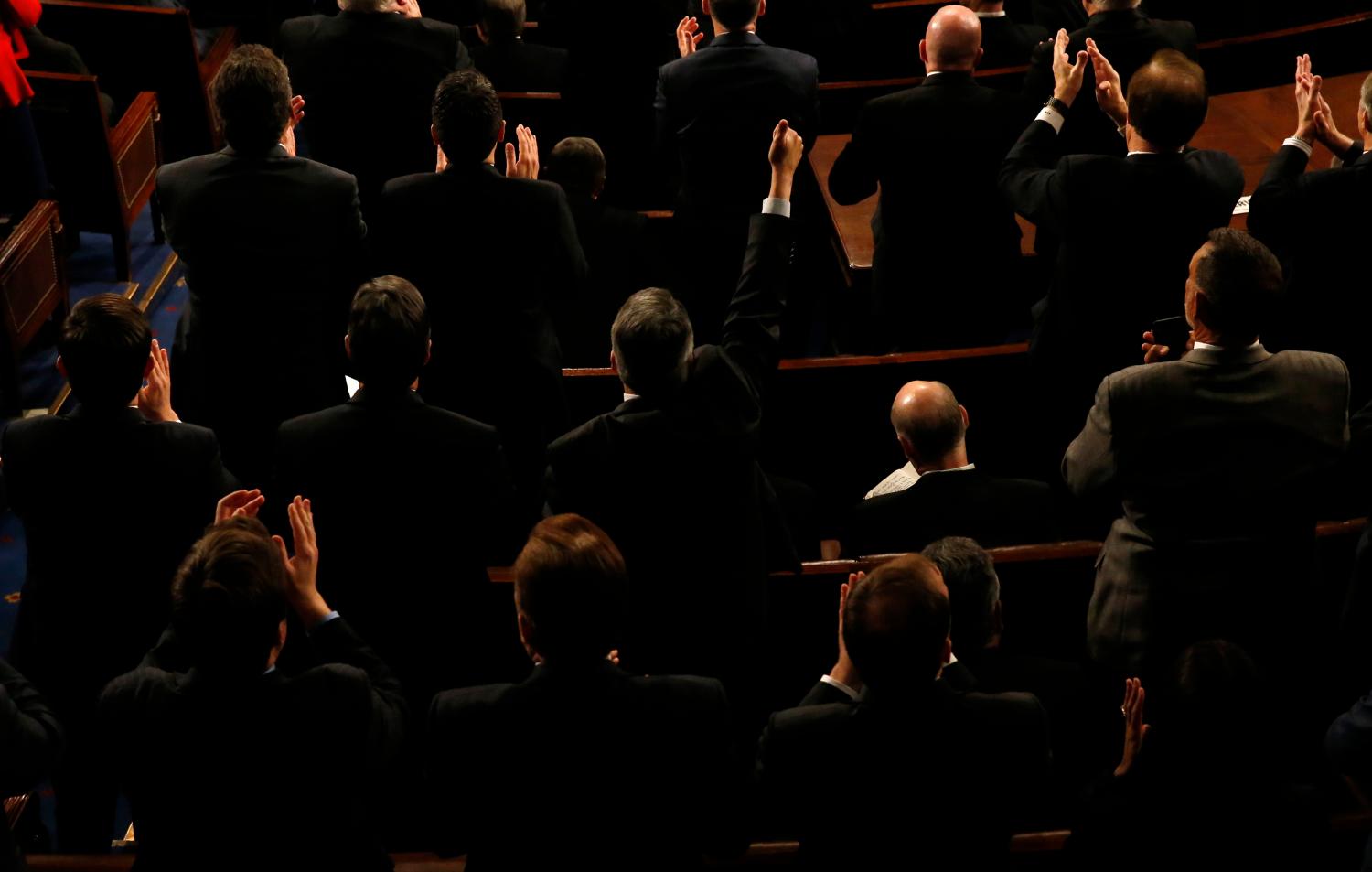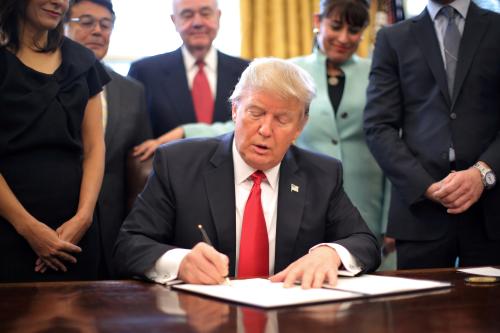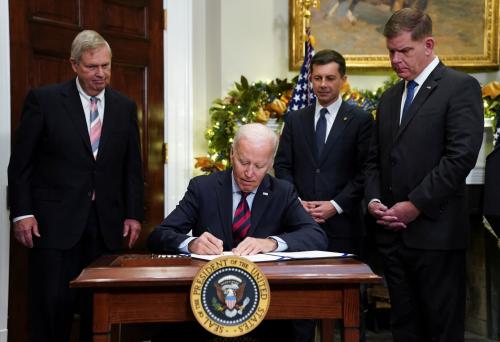This report is part of the Series on Regulatory Process and Perspective and was produced by the Brookings Center on Regulation and Markets.
Resisting the Trump administration is the order of the day for most Democrats and much of our commentariat. And yet, one of the bills that would do the most to check the executive branch’s ability to act arbitrarily has almost no Democratic support and next to no coverage in the mainstream press.1
The bill is the Regulatory Accountability Act (RAA), S. 951, sponsored by Sen. Rob Portman (R-OH). The Senate Homeland Security and Governmental Affairs Committee approved the bill 9-5 in May 2017, and issued its Committee Report last month. The bill will now look for a way to get to 60 votes in the Senate, but its prospects do not look bright.
Why have the politics developed in this way, especially considering progressives’ widespread desire to find ways of boxing in the Trump administration? There are principled and cynical explanations, both worth examining.
On a principled basis, the RAA’s supporters present the bill as an effort to update the Administrative Procedure Act (APA) in line with the recommendations of such nonpartisan expert groups as the American Bar Association and the Administrative Conference of the United States. The RAA, its supporters claim, is meant to codify and build on the practices of prospective and retrospective benefit-cost analysis that administrations of both parties have developed over the last four decades.
It does so by making APA compliance conditional on the quality and rigor of the analyses, so that if agencies skip the necessary analysis or do it badly, judges can reverse their substantive actions (or merely suspend them, by remanding without vacatur, as per the Act’s proposed change to 5 U.S.C. § 706). All these requirements would apply just as much to deregulatory actions as to new regulations.
Oddly enough Republicans, sometimes portrayed (by themselves and others) as opponents of the administrative state writ large, here present themselves as its truest defenders, working to incrementally strengthen the process and therefore ensure its legitimacy.
The RAA’s opponents, on the other hand, attack the bill as a wolf in sheep’s clothing. They argue that the benefit-cost analysis practices that have served agencies well when developed and implemented independently will be transformed by the RAA into a straitjacket meant to frustrate all attempts at further regulation. New requirements to develop full cost-estimates for three alternatives will slow down the regulatory process and create new opportunities for industry groups to tie up agencies in litigation.
They also object to bringing independent agencies’ benefit-cost efforts under the auspices of the Office of Information and Regulatory Affairs (OIRA), as the RAA would do, noting the importance of preserving agency independence. In their words, the RAA does not provide for real “accountability” because “[n]othing in the bill, for instance, would compel an agency to protect the public against predatory lending practices or foodborne illness.” The bill’s critics thus position themselves as defenders of a powerful executive branch, some parts of which are deliberately kept free of presidential or OIRA involvement, with their chief concern being agencies’ ability to pursue their missions efficiently.”
So the principled differences are real, if ironic. Republicans, thrilled to have their appointees directing regulatory agencies after the long Obama years, are nevertheless seeking to ensure that the executive branch’s outputs are more meticulously developed, winning plaudits from the likes of Cass Sunstein. Democrats, on the other hand, are standing up for a more autonomous, “independent” executive branch–even as they take to the airwaves to warn of the grave damages the current president can cause because of the executive’s great power and denounce several agency heads as hopelessly corrupt.
Admittedly, these ironies fade somewhat when taking a more cynical view. For conservative Republicans, the most important triumph during the Trump administration has been the appointment of conservative judges. It is reasonable to expect that by the end of Trump’s term, Republican appointees will make up a majority of federal judges at the appellate level, as well as on the Supreme Court.2 Given the very real possibility of coming electoral difficulties, conservatives may view the courts as their most durable power center in coming years. Creating new opportunities for challenging agency actions in court is thus a natural way to shift policy in a more conservative direction.
Democrats, meanwhile, can be seen as already planning for Jan. 20, 2021, when they hope Donald Trump’s (or Mike Pence’s!?) successor will take the oath of office and then quickly proceed to reverse Trump administration executive actions en masse. As that president and his or her appointees engage in that work on behalf of the public good (not to mention Democratic interests), Democrats prefer that they face as few encumbrances as possible. As wholesome as “checking every action against viable alternatives” sounds, in the end it is just a way for special interests to give themselves extra opportunities to exploit the judiciary’s lack of expertise. Perhaps opponents of the Trump administration also think there are already sufficient legal tools to bring wayward agencies to heel.
For what it’s worth, the principled stories seem to me to be at least as powerful as the cynical ones. There is a real disagreement between the parties about the relationship between the executive and the other branches, and it appears to be more than just a passing hangover of the Obama years. Indeed, it seems to run considerably deeper than the disagreements over the Trump administration that fill up so much of our current media coverage. If President Trump could be bothered about such things, he’d surely be amused.
Philip Wallach is a senior fellow in the governance project at the R Street Institute. The author did not receive financial support from any firm or person for this article or from any firm or person with a financial or political interest in this article. He is currently not an officer, director, or board member of any organization with an interest in this article.
-
Footnotes
- The bill is co-sponsored by Sens. Heidi Heitkamp (D-ND) and Joe Manchin (D-WV), and so was for a while touted as “bipartisan,” but apparently it has little, if any, Democratic support in the Senate beyond them.
- The Supreme Court currently has five Republican and four Democratic appointees, while the Courts of Appeals have a total of 75 Republican and 87 Democratic appointees, as well as 17 vacancies. President Trump has made an additional 10 nominations of appellate judges that are currently pending. Of course, if Democrats take control of the Senate after the 2018 midterm elections and vigorously fight Trump’s judicial nominees, it is possible that Democratic appointees could remain a majority in the courts of appeals through 2020.





